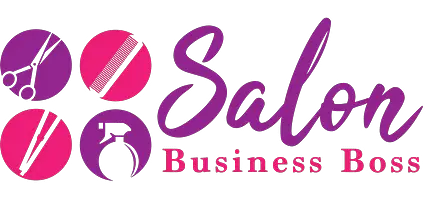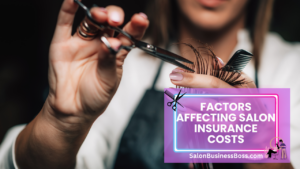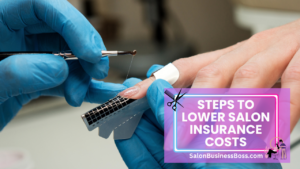Salons, whether hair salons, nail salons, or beauty spas, are vibrant spaces where professionals cater to the grooming needs of their clientele. Amidst the creativity and artistry, it is crucial for salon owners to prioritize the protection of their businesses and assets.
Salon insurance cost about $390 per year on average. It offers protection against liabilities and risks, including general liability, professional liability, and property insurance. Factors like business size, services offered, and location influence the cost. Optional add-ons like cyber liability and business interruption coverage are available for enhanced protection.
1. Understanding Salon Insurance Coverage:
Salon insurance serves as a crucial shield for salon owners, offering comprehensive coverage against a variety of potential risks and liabilities. This tailored insurance policy is designed to address the specific needs and vulnerabilities of salons, ensuring the business remains protected and resilient.
A typical salon insurance policy encompasses three essential components: general liability insurance, professional liability insurance, and property insurance. General liability insurance acts as the primary layer of protection, covering bodily injury and property damage claims that might arise on the salon premises. Whether it’s a slip and fall accident or damage to a customer’s belongings, this coverage shields salon owners from costly legal battles and compensation claims.
Professional liability insurance, often referred to as malpractice insurance, is tailored to safeguard the salon against claims stemming from unsatisfactory services or negligence on the part of the salon staff. In the event that a client files a lawsuit for a botched hair treatment or a chemical service gone wrong, this coverage provides financial support for legal expenses and potential settlements.
Property insurance, the third component of salon insurance, plays a vital role in preserving the salon’s physical assets. This coverage protects valuable items like furniture, equipment, and inventory from damage or loss caused by covered perils such as fire, theft, vandalism, or natural disasters. The reassurance that the salon can quickly recover from unexpected incidents ensures uninterrupted business operations and minimal financial strain.
Salon owners can customize their insurance policies by adjusting coverage limits and adding optional coverages based on their unique requirements. The comprehensive protection provided by salon insurance offers peace of mind to salon owners, allowing them to focus on their craft and delivering exceptional services to their clientele without undue worry about potential financial setbacks.
2. Factors Affecting Salon Insurance Costs:
Various factors contribute to determining the cost of salon insurance. Some of the key factors include:
a. Business Size and Revenue:
The size of a salon, as indicated by the number of employees and its annual revenue, plays a pivotal role in determining insurance premiums. Larger salons with more staff and higher revenues are exposed to increased risks due to a larger client base and higher foot traffic. As a result, insurers may perceive them as more susceptible to potential liability claims, leading to higher insurance costs. Moreover, larger salons may possess a greater number of valuable assets, equipment, and inventory, which necessitates higher coverage levels. Salon owners should carefully assess their business’s size and revenue when selecting insurance policies, ensuring adequate protection without overburdening their budget.
b. Services Offered:
The scope of services provided by a salon can significantly impact insurance costs. Different salon services entail varying levels of risk exposure. For instance, a salon offering hair treatments involving chemicals and dyes may face a higher probability of client dissatisfaction or allergic reactions, leading to increased claims and potentially higher premiums. Conversely, a salon focusing solely on nail services might have fewer associated risks, resulting in lower insurance costs. Salon owners must accurately disclose the services they provide when obtaining insurance quotes to ensure they receive appropriate coverage and accurate premium estimates.
c. Location:
The geographical location of a salon holds relevance in determining insurance costs. Salons situated in areas with higher crime rates may face increased risks of theft, vandalism, or break-ins, leading to higher premiums to mitigate potential losses. Additionally, salons located in regions susceptible to natural disasters such as hurricanes, floods, or earthquakes may encounter higher insurance costs due to the added risk of property damage. Insurance providers assess location-specific risks to tailor coverage accordingly, necessitating salon owners to consider their salon’s location when evaluating insurance options.
d. Claims History:
A salon’s claims history serves as a critical factor influencing insurance costs. Insurers review past insurance claims to gauge the salon’s risk profile and predict future liabilities. A history of frequent and severe claims suggests a higher likelihood of future claims, prompting insurers to adjust premiums accordingly to accommodate the increased risk exposure. Salon owners can proactively manage their claims history by implementing risk management strategies, prioritizing safety protocols, and addressing client concerns promptly. A positive claims history can lead to more favorable insurance rates and enhanced long-term financial stability.
e. Coverage Limits and Deductibles:
The extent of coverage and deductibles chosen by a salon owner significantly impacts insurance premiums. Higher coverage limits, which provide greater financial protection in the event of a claim, often lead to higher premiums. Conversely, selecting lower coverage limits may reduce premiums but leave the salon vulnerable to potential gaps in coverage. The deductible amount, which represents the salon owner’s out-of-pocket expense before the insurance coverage kicks in, influences premium costs. Opting for lower deductibles generally results in higher premiums, while higher deductibles may lead to lower premium costs. Salon owners must strike a balance between coverage levels and deductible amounts to tailor insurance policies that meet their budgetary constraints and risk tolerance.
Read more about: The Cost of Opening a Hair and Nail Salon
3. The Average Cost of Salon Insurance:
The estimated average cost of salon insurance at around $390 per year is a result of considering various factors that influence insurance premiums for salon businesses. However, it’s essential to recognize that this figure is a general average and may not apply universally to all salons. Each salon’s unique circumstances, such as size, services offered, location, claims history, and coverage preferences, can lead to significant variations in insurance costs.
The $390 per year average is based on a standard insurance policy with basic coverage limits and deductibles. Salon owners seeking more extensive coverage or additional optional add-ons may experience higher premium costs. Conversely, those with smaller salons, limited services, and lower revenue might find more cost-effective insurance options.
The average cost of salon insurance can also be influenced by market conditions, regulatory changes, and industry trends. Insurance providers may periodically adjust their rates and offerings, affecting the overall cost of salon insurance.
To obtain accurate and tailored insurance quotes, salon owners should engage in a comprehensive evaluation of their specific business needs and risk profile. Seeking quotes from multiple insurance providers and comparing coverage options will empower salon owners to make informed decisions and secure the most suitable and competitive insurance policy for their unique requirements.
4. Additional Coverages and Optional Add-ons:
In addition to the core coverage, salon owners have the option to enhance their insurance policy with additional coverages and optional add-ons. Some of the common optional coverages include:
a. Cyber Liability Insurance:
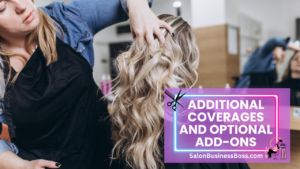
As technology becomes increasingly integrated into salon operations, the risk of cyber threats and data breaches grows substantially. Cyber liability insurance provides essential protection against these digital risks. This specialized coverage helps safeguard salons from financial losses and reputational damage resulting from data breaches, hacking attempts, or other cyberattacks. In the event of a data breach, cyber liability insurance can cover the costs of notifying affected clients, hiring forensic experts to investigate the breach, and providing credit monitoring services. It may also extend coverage for legal expenses and settlements in case of third-party lawsuits arising from the breach. By investing in cyber liability insurance, salon owners can fortify their businesses against the evolving landscape of cyber threats and ensure the safety of sensitive customer information.
b. Business Interruption Insurance:
Business interruption insurance serves as a vital lifeline for salons facing temporary closures due to covered perils such as fires, natural disasters, or other unexpected events. When a salon’s operations are disrupted, it can lead to significant financial challenges, including lost revenue and ongoing expenses that continue even during the downtime. Business interruption insurance provides financial support by covering lost income during the closure period, helping the salon meet financial obligations like rent, employee salaries, and utility bills. This coverage aims to mitigate the financial impact of unexpected interruptions, allowing salon owners to focus on rebuilding and resuming business operations without facing severe financial strain. By including business interruption insurance in their salon insurance policy, business owners can proactively protect their livelihoods from the uncertainties of unforeseen events.
c. Employment Practices Liability Insurance (EPLI):
Employment practices liability insurance (EPLI) is a critical coverage designed to shield salons from potential lawsuits related to employment practices. Accusations of wrongful termination, discrimination, harassment, or other employment-related issues can result in costly legal battles that have the potential to tarnish a salon’s reputation. EPLI coverage steps in to cover legal expenses, such as defense costs and settlement payments, in the event of such claims. Salon owners may implement strong HR practices and maintain a respectful workplace environment, but they are still susceptible to employment-related lawsuits. EPLI provides a safety net, reassuring salon owners that they have financial protection in the face of potential employment-related liabilities. It empowers salon businesses to navigate the complexities of employment practices while safeguarding their assets and preserving their brand reputation.
d. Equipment Breakdown Coverage:
The smooth operation of salon equipment is essential to delivering high-quality services and ensuring customer satisfaction. Equipment breakdown coverage is tailored to protect salon owners from the financial consequences of vital equipment malfunctioning or breaking down. If essential salon equipment, such as hairdryers, styling chairs, or specialized machinery, suffers a mechanical or electrical breakdown, this coverage helps cover the costs of repair or replacement. Without this coverage, salon owners may face substantial expenses for repairing or replacing expensive equipment, impacting their ability to maintain normal operations. Equipment breakdown coverage offers financial relief, allowing salon owners to swiftly address equipment issues and continue providing seamless services to clients. By investing in this coverage, salon owners can ensure the longevity and efficiency of their equipment, minimizing disruptions to daily operations and enhancing the overall customer experience.
5. Steps to Lower Salon Insurance Costs:
Salon owners can take proactive measures to manage their insurance costs effectively:
a. Risk Mitigation:
Implementing risk mitigation strategies is crucial for salon owners to proactively protect their businesses from potential hazards and minimize the occurrence of accidents or incidents. By identifying potential risks unique to their salon, owners can design and enforce safety measures and risk management practices. This may include staff training on safety protocols, regular equipment maintenance, and maintaining a clean and hazard-free salon environment. Implementing a thorough client consultation process and ensuring proper client disclosure of allergies or medical conditions can also reduce the risk of adverse reactions to salon treatments. By prioritizing risk mitigation, salon owners can not only enhance the safety and well-being of their clients and staff but also potentially qualify for lower insurance premiums, as insurers view proactive risk management as a positive attribute.
b. Comparison Shopping:
Salon owners should exercise due diligence when seeking insurance coverage by engaging in comparison shopping. Obtaining quotes from multiple insurance providers allows owners to evaluate different policy options, coverage limits, deductibles, and premium rates. By comparing various insurance offerings, salon owners can identify competitive rates and uncover the best-suited coverage for their specific business needs. Moreover, the process of comparison shopping enables salon owners to gain a comprehensive understanding of the insurance market, ensuring they make informed decisions when selecting an insurance provider. By investing time in comparison shopping, salon owners can secure cost-effective insurance solutions without compromising on the quality and extent of coverage they need to safeguard their businesses.
c. Bundle Policies:
Bundling salon insurance with other business insurance policies presents an opportunity for salon owners to optimize their insurance coverage and potentially reduce costs. Combining salon insurance with commercial property insurance, general liability insurance, or other relevant policies under a single insurance provider often results in discounted premiums. Insurance companies value customer loyalty and view policy bundling as a sign of a long-term business relationship, encouraging them to offer cost savings for bundled packages. Beyond potential cost savings, bundling policies also simplifies administrative tasks, as salon owners deal with a single insurer for multiple coverages. This streamlining of insurance management frees up time for salon owners to focus on core business activities. By bundling policies, salon owners can maximize their insurance investment and enjoy the convenience of a comprehensive insurance solution tailored to their specific business requirements.
Read more about: How can I open a beauty salon with no money?
Conclusion
Salon insurance is an indispensable investment for salon owners, providing protection against unforeseen risks and potential financial liabilities. The average annual cost of $390 per year reflects a balance between essential coverage and affordability. By understanding the factors influencing insurance costs and exploring optional add-ons, salon owners can tailor their insurance policies to meet their specific needs while maintaining budgetary constraints. Striking this balance ensures the longevity and success of salon businesses in an unpredictable world.
Frequently Asked Questions
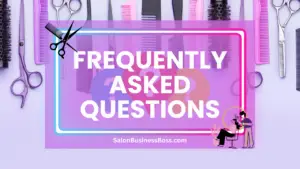
1. How can I lower the cost of salon insurance?
Implementing risk mitigation strategies, seeking competitive quotes from multiple insurance providers, and bundling policies can help lower insurance costs.
2. Will my salon’s location affect the insurance premium?
Yes, the location of your salon can influence insurance costs. Salons in areas with higher crime rates or increased risk of natural disasters may have higher premiums.
3. Does my claims history impact the cost of insurance?
Yes, a history of frequent insurance claims may lead to higher premiums as insurers perceive a higher risk associated with the salon.
To learn more on how to start you own salon checkout my startup documents here.
Please note that the contents of this blog are for informational and entertainment purposes only and should not be construed as legal advice. Any action taken based on the information provided in this blog is solely at your own risk. Additionally, all images used in this blog are generated under the CC0 license of Creative Commons, which means they are free to use for any purpose without attribution.

About the author. Entrepreneur and Salon Business Fan.
Hi! I am Shawn and I am a happy individual who happens to be an entrepreneur. I have owned several types of businesses in my life from a coffee shop to an import and export business to an online review business plus a few more and now I create online salon business resources for those interested in starting new ventures. It’s demanding work but I love it. I do it for those passionate about their business and their goals. That’s why when I meet a salon business owner, I see myself. I know how hard the struggle is to retain clients, find good employees and keep the business growing all while trying to stay competitive.
That’s why I created Salon Business Boss: I want to help salon business owners like you build a thriving business that brings you endless joy and supports your ideal lifestyle.
